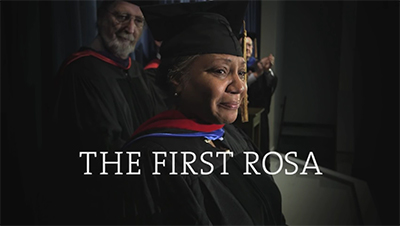Rosa J. Young: Saint of the Reformation Faith

by Ward I. Yunker
Rosa J. Young is not a saint who lived in the Reformation era. But she is certainly a saint of the Reformation faith.
In Reformation history, we often refer to the importance of the “First Martin” and a “Second Martin”. The first Martin is the Reformer Martin Luther. The second Martin is Martin Chemnitz, the later Lutheran theologian who was one of the chief authors of the Formula of Concord.
Likewise, American Lutherans—especially African American Lutherans in central Alabama—know of a “First Rosa” and a “Second Rosa”. The “Second Rosa” is Rosa Parks—the well-known seamstress from Montgomery, Alabama, whose refusal to give up her seat on a bus to a white man started the Montgomery bus boycott, the Civil Rights Movement in the United States, and the career of Martin Luther King, Jr. as a civil rights leader.
But the first Rosa is African American Lutheran educator and missionary Dr. Rosa Jinsey Young. Rosa Young was born in Rosebud, Alabama on May 14, 1890. Most African Americans in Alabama in those days lived in grinding poverty. Young writes, “The educational advantages offered these children by the State were entirely inadequate. The school terms lasted three or four months a year. Before the children could get a good start in school, the term would be over.”
The teaching of local churches was often likewise deficient. “The religion of my people was a manufactured religion,” Young writes. The doctrine sometimes taught in rural Southern black churches was drawn not from Holy Scripture, but from the heads of ill-prepared preachers—some of whom were not above taking advantage of their flocks.
Rosa Young was different. For one thing, she was brilliant. In her childhood, she absorbed learning like a sponge and home-schooled her siblings in similar manner. She writes, “I think my teaching must not have been too bad…” She also came from a devout family. Her father was a pastor in the African Methodist Episcopal Church for twenty years, and her mother was described as “a woman of high morals.”
Young attended Payne University in Selma, Alabama (named for a pastor who was trained as a Lutheran, but later became a bishop of the AME Church.) Not long after graduation, she returned to her hometown in Rosebud, Alabama, and there opened a school for African American children—a big decision. As Deaconess Jeni Miller of The Lutheran Church—Missouri Synod writes, “Not many women in their 20s typically set out to open their own school in the rural south in the early 1900’s, and she was just getting started!”

Rosa Young as portrayed by Yvette Jones-Smedley in the 2016 film The First Rosa.
But times were tough: the Mexican boll weevil made its way east from Texas to Alabama, destroying cotton crops in its path. This left most of the parents in Rosebud unable to support Rosa’s school. She appealed to the AME church in which she grew up for support, but they were unable to take ownership of the school. Other churches and organizations were similarly unable to help Rosa. Finally, she wrote to Dr. Booker T. Washington of the Tuskegee Institute. He was unable to help personally, but he recommended that she contact Christopher Drewes of the Evangelical Lutheran Synodical Conference (an association of Lutheran church bodies in which the Lutheran Church-Missouri Synod took a leading role).
In response to Young’s request, Drewes sent veteran pastor Nils Julius Bakke to Rosebud to meet Rosa and visit her school. On Rev. Baake’s recommendation, the Synodical Conference took ownership of the Rosebud school. Christ Lutheran Church in Rosebud was planted not long after that. In this way, the Lutheran faith came to the central Alabama “Black Belt”.
Rosa Young spent the next several decades assisting in the planting of Lutheran Churches and schools in central Alabama. Martin Luther writes, “Oratio, meditatio, tentatio—prayer, meditation, trials—these things make a theologian.” Rosa Young certainly faced trials in her life—and not just the boll weevil and threats from the Ku Klux Klan and other white supremacists. (Rev. Baake had himself had a run-in with the Klan before he ever met Rosa Young.) More than all this, what really hurt Rosa was when former friends turned on her and spread rumors and lies because of the disturbance caused in their formerly quiet lives by the spread of the Lutheran faith. But she persisted.
Deaconess Miller summarizes Young’s impact in this way: “Rosa Young was passionate about educating children and sharing the Gospel. She accomplished extraordinary things for her community and the kingdom of God and was later dubbed the ‘Mother of Black Lutheranism in Central Alabama.’ She was instrumental in founding and promoting 30 elementary schools and 35 Lutheran congregations in Alabama’s ‘Black Belt.’ But her legacy isn’t confined only to Alabama; her students went on to become LCMS teachers and pastors, serving schools and congregations around the country.”
Later in life, Young would became a professor at the Alabama Lutheran Academy an College in Selma (known today as Concordia College, Selma). She would eventually receive an honorary doctorate from Concordia Theological Seminary of Springfield, Illinois (now located in Fort Wayne, Indiana) in 1961.
Rosa Young passed away on June 30, 1971. And while she may not have lived in the Reformation era, she is a saint of God who brought the Reformation faith to central Alabama. For that, we give thanks.
Rev. Ward I. Yunker is pastor of Grace Lutheran Church in Beausejour, Manitoba.
You can find out more about Rosa J. Young in the 2016 film The First Rosa. For more information, visit www.lcms.org/thefirstrosa.





